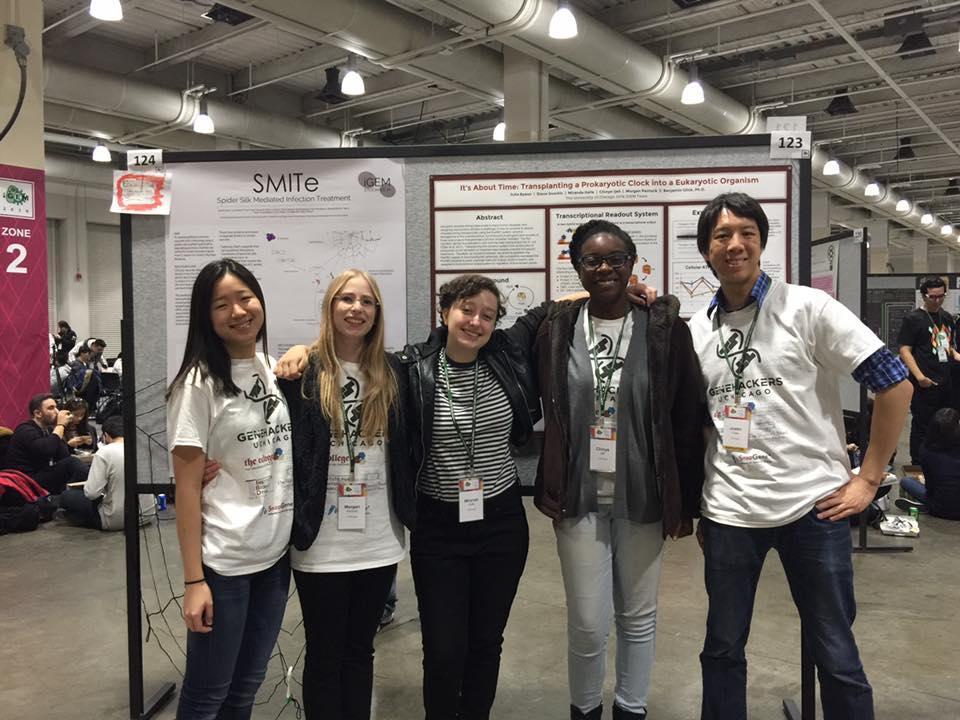
Every year, groups of teenagers gather together and brainstorm ways to save the world—with science. The International Genetically Engineered Machine (iGEM) Foundation is a non-profit organization that is dedicated to educating young scientists and enhancing open community and collaboration in the field of synthetic biology. They hold a competition every year with hundreds of teams participating from around the world.
Last year, Promega provided cloning reagents to the University of Chicago iGEM team, and they received a bronze medal for their work. We asked two of the team members, Steve Dvorkin and Julia Byeon, about their experience. Steve is a junior and majors in biology; he is co-president of the team this year. Julia recently graduated and works in public policy.
Q1. What is iGEM?
S: iGEM is an international competition where students around the world, ranging from high school to undergraduates to graduates, can create projects that use synthetic biology in some way to solve certain problems in the world. Each year, we all gather together in the Giant Jamboree and present our work.
J: iGEM is a creative outlet for young scientists all over the world. Providing this kind of outlet, and then adding a competitive edge, is a great way to incentivize people to come up with all sorts of, sometimes silly, but often brilliant and innovative ideas.
Q2. What was your project about?
S: We took three proteins that control the circadian clock in cyanobacteria and tried to transfer them into yeast. We wanted to see if we could put gene expression under the control of the new circadian rhythm. This is a proof-of-concept that bacterial circadian genes can be transformed into eukaryotic organisms. We thought this could have several therapeutic uses. For example, there are some cancers that are caused by cells losing their own circadian control. This could also help treat human circadian rhythm sleep disorders. On the sillier but also applicable side, we’re thinking of things like “time zone pills”. You could get on a plane and take a pill filled with some yeast that will reset your time zone to prevent jet lag.
Q3. What are some of the difficulties you encountered during the competition?
S: Although we have graduate advisors and PI advisors, all of our team members are undergrads. We do most of the work ourselves, and we design the experiments ourselves. It’s a learning process every year when we start creating a project. We’re still learning what experiments we can do and how to do them.
The timeframe is also difficult. We have to complete the project within three months, which is a pretty short period for a substantial project. It’s always a time rush to see what we can actually do in time. Especially since, in science, nothing goes according to plan. Something will always go wrong.
Q4. Was it hard working as a team?
S: Actually, I think teamwork was definitely one of our strengths. We recruit members in the fall, and we do a lot of group bonding activities throughout the year. We plan our project completely together and hold weekly meetings. There’s always good communication between lab members. We really get to know one another.
Q5. What do you remember most about the 2016 Giant Jamboree?
J: I remember how large the competition was. There were an endless number of teams and projects to look through every day. What was really memorable was the wide range of funding and resources available to all of the teams. Some teams had giant labs equipped with everything they needed, while others had much less to work with. It was interesting to see the kinds of projects people were able to accomplish with what was available to them.

Q6. What were some of the memorable projects by other teams?
J: One team tried to demonstrate that their project on perchlorate reductase would work on Mars. They put dog poop in a flask and then put a condom over the flask opening. If the condom inflated, the reaction was working!
I also remember a team that was responding to a lack of electricity in their hometown by making book lights. They put florescent bacteria into disposable plastic pipettes and made 3D-printed stands to hold the glowing pipettes. I thought it was really creative and resourceful, as well as responsive to local issues.
Q7. What have you learned through this experience?
S: Professionally, I learned so much about the theories behind these scientific techniques. Because I was part of the team designing our projects, I really got to learn how cloning actually works. I designed all the primers and plasmids, and became familiar with the process. I learned a great deal about how to design and plan out experiments, and it’s been very useful to me.
Personally, I grew more confident. I learned that I had the ability to understand these scientific theories and design projects on my own. It was a great confidence boost and helped me further my love for science. In fact, I just joined a new lab that I plan to stay through the rest of college. I’m studying the effects of some viruses on the innate immune system and their interactions.
Promega is proud to sponsor the University of Chicago iGEM team again this year and we wish them the best of luck! Registration for the 2017 iGEM competition ends on August 31. To learn more, visit their site at igem.org.
Competing in iGEM? Learn more about how you can get support for your iGEM project at our website and check out our resources for iGEM teams, including Q&A webinars and tips for creating scientific posters.
Latest posts by Johanna Lee (see all)
- Microfluidic Organoids Could Revolutionize Breast Cancer Treatment - March 25, 2025
- Bacteria From Insect Guts Could Help Degrade Plastic - January 28, 2025
- A Diabetes Drug, Metformin, Slows Aging in Male Monkeys - December 19, 2024
